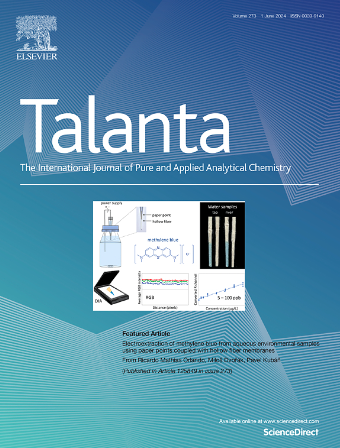IF 5.6
1区 化学
Q1 CHEMISTRY, ANALYTICAL
引用次数: 0
摘要
苯胺污染物会对人类健康和生态系统造成巨大危害,而快速、选择性地定量检测环境样品中痕量苯胺化合物是一个非常复杂的目标。本研究基于假分子印迹聚合物(DMIP)制作了一种新型、高效的纳米通道传感器。该传感器的工作原理是离子电流在不对称带电纳米多孔毛细管上的整流。借助电-浓度多场耦合模型和对照实验,研究了离子在纳米多孔毛细管中的分布和传输情况,并探讨了优化传感器的关键影响因素。在 1 nmol/L ∼0.1 mmol/L 的浓度范围内,纳米传感器的整流比与苯胺浓度的对数呈良好的线性关系,检出限为 0.2 nmol/L。使用 DMIP 纳米通道传感器测试了真实海水样品中苯胺的浓度,平均回收率为 88.31%。所制备的基于 DMIP 纳米通道的传感器具有成本低、体积小、操作简单、准确度高和重现性好等优点,是一种用于实际环境样品中痕量苯胺检测的理想方法。本文章由计算机程序翻译,如有差异,请以英文原文为准。

Dummy molecularly imprinted polymer nanochannel sensor for ultrasensitive detection of aniline compounds
Aniline pollutants can cause great harm to human health and the ecosystem, while rapid and selective quantification of aniline compounds in environment samples at trace levels is a highly complex target. In this study, a novel, efficient nanochannel sensor based on dummy molecularly imprinted polymer (DMIP) was fabricated. The sensor works on the principle of the ion current rectification across the asymmetric charged nanoporous capillary. With the help of the electric-concentration multi-field coupling model and controlled experiments, the ion distribution and transport in the nanoporous capillary. and the key influencing factors were examined for optimization of the sensor. At the concentration of 1 nmol/L ∼0.1 mmol/L, the rectification ratio of the nanosensor and logarithm aniline concentration exhibited a good linear relationship with the limit of detection of 0.2 nmol/L. The concentration of anilines in the real seawater sample was tested with the DMIP nanochannel sensor, and the average recovery rate was 88.31 %. The prepared DMIP nanochannel based sensor has established itself a promising method for trace aniline detection in real environmental samples, with the advantages of low cost, small size, simple operation, high accuracy and excellent reproducibility.
求助全文
通过发布文献求助,成功后即可免费获取论文全文。
去求助
来源期刊

Talanta
化学-分析化学
CiteScore
12.30
自引率
4.90%
发文量
861
审稿时长
29 days
期刊介绍:
Talanta provides a forum for the publication of original research papers, short communications, and critical reviews in all branches of pure and applied analytical chemistry. Papers are evaluated based on established guidelines, including the fundamental nature of the study, scientific novelty, substantial improvement or advantage over existing technology or methods, and demonstrated analytical applicability. Original research papers on fundamental studies, and on novel sensor and instrumentation developments, are encouraged. Novel or improved applications in areas such as clinical and biological chemistry, environmental analysis, geochemistry, materials science and engineering, and analytical platforms for omics development are welcome.
Analytical performance of methods should be determined, including interference and matrix effects, and methods should be validated by comparison with a standard method, or analysis of a certified reference material. Simple spiking recoveries may not be sufficient. The developed method should especially comprise information on selectivity, sensitivity, detection limits, accuracy, and reliability. However, applying official validation or robustness studies to a routine method or technique does not necessarily constitute novelty. Proper statistical treatment of the data should be provided. Relevant literature should be cited, including related publications by the authors, and authors should discuss how their proposed methodology compares with previously reported methods.
 求助内容:
求助内容: 应助结果提醒方式:
应助结果提醒方式:


